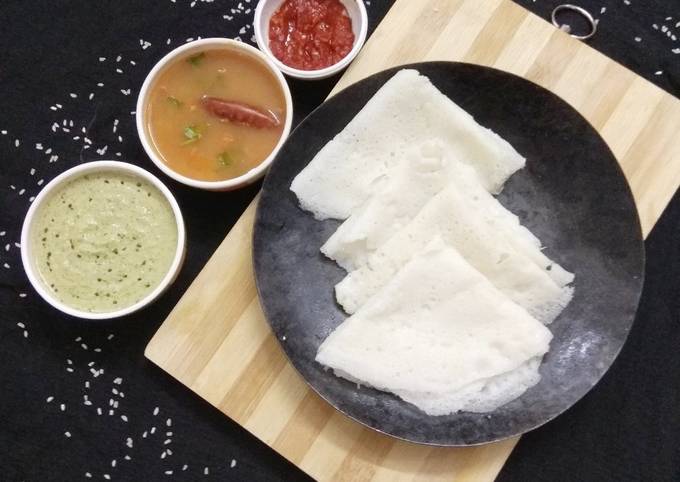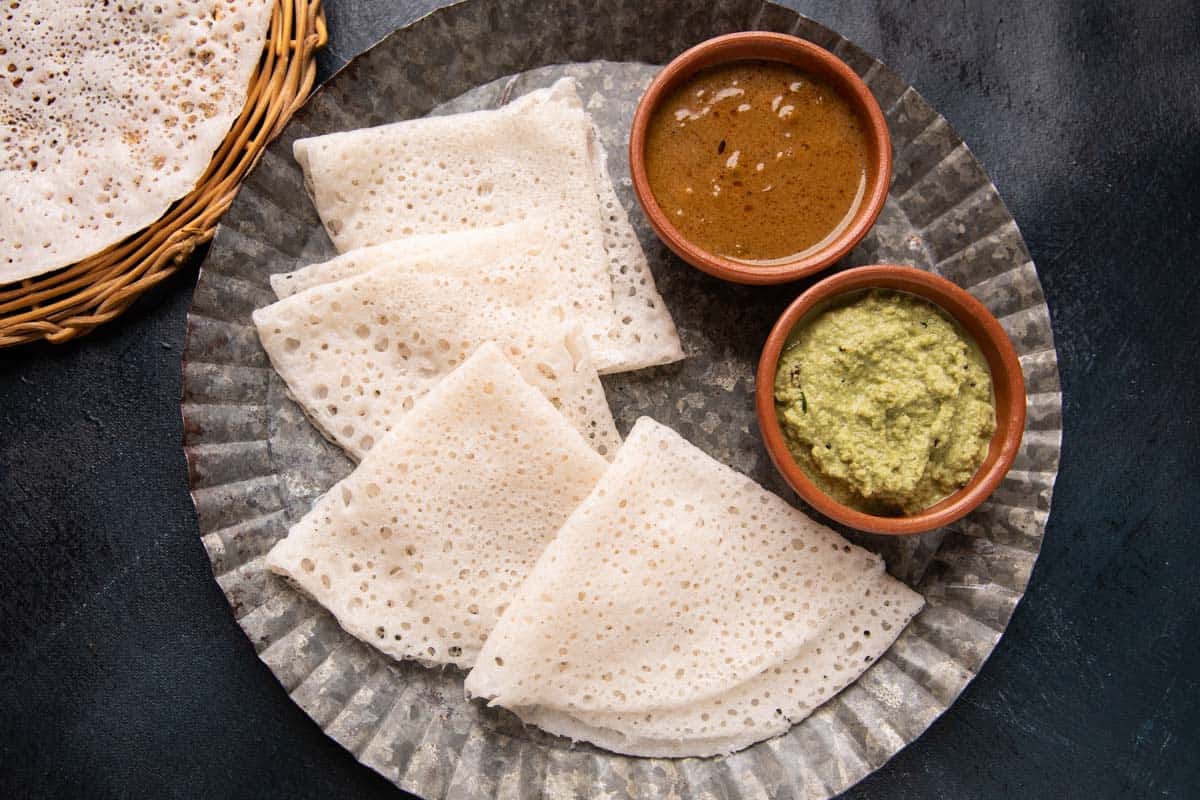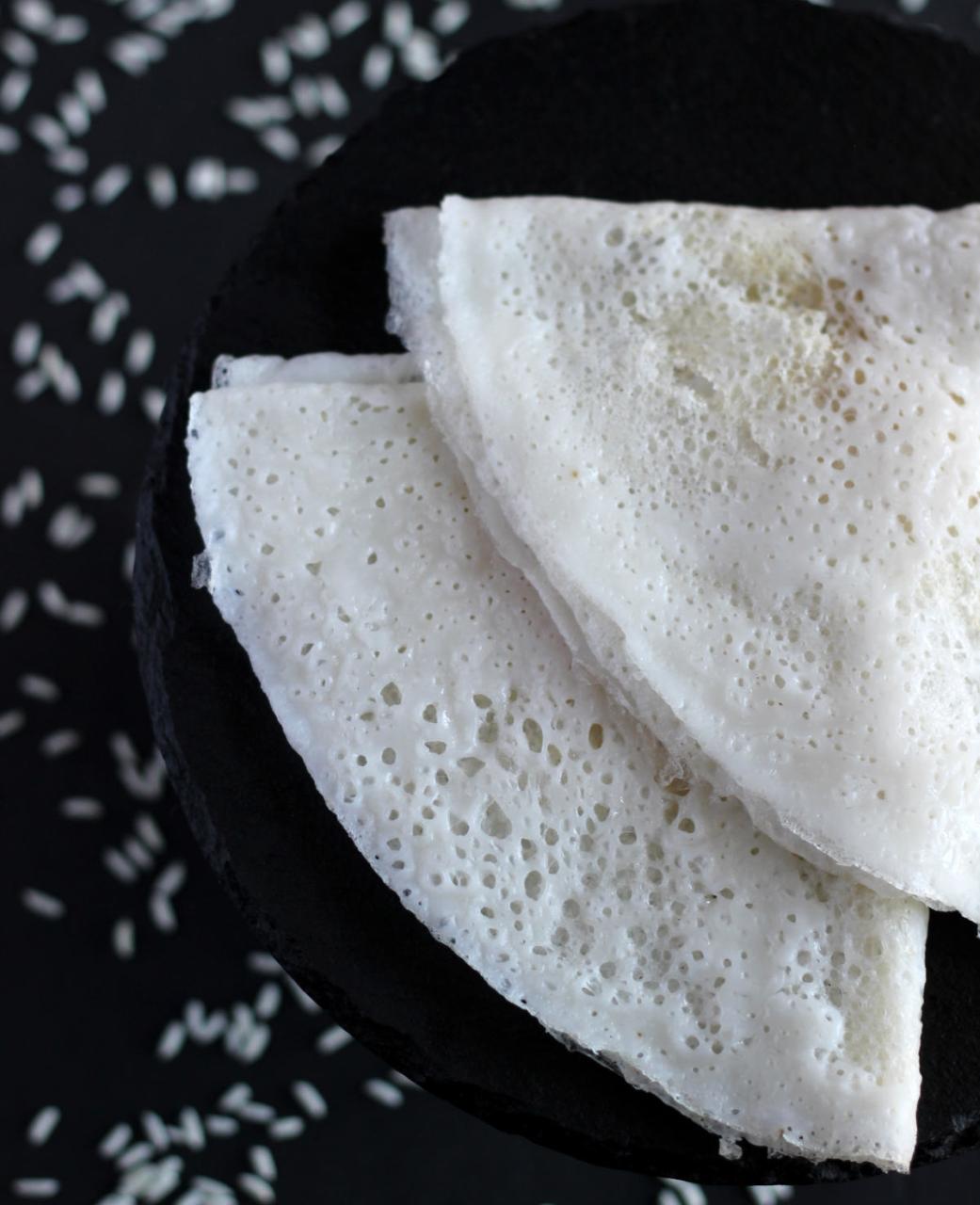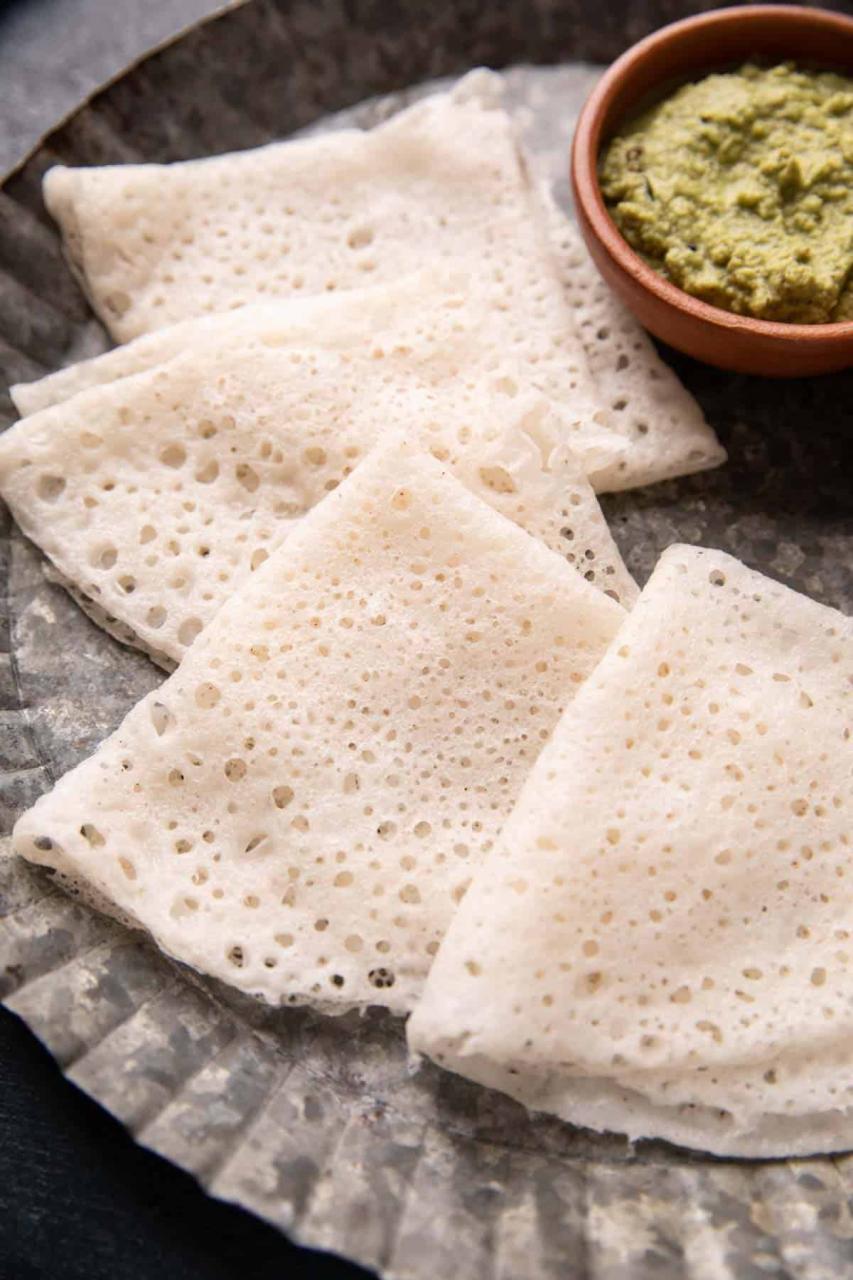Imagine the tender embrace of morning light as it filters through the leaves, casting a soft glow upon your breakfast table set with the daintiest of fares. This is where Neer Dosa, the Soft and Lacy Rice Crêpes from the coastal heartlands of Karnataka, India, makes its delicate entrance. To unfold a Neer Dosa is to unveil a tale spun with gossamer threads of rice batter, conjuring images of dew-kissed mornings and the promise of a meal both humble in its creation and majestic in its simplicity.
The magic of Neer Dosa lies not just in its featherlight texture or its enchanting translucence, but in its unpretentious versatility. So deceptively simple in its ingredients—soaked rice ground to a fine, almost silken whisper of a batter, watered to a flowing consistency—it belies the incredible experience that awaits the palate. With no fermentation required, each crêpe cooks to airy perfection on the warm skillet, speaking of traditions that value time-honored recipes whilst respecting the pace of modern life.
Neer Dosa SoftandLacy RiceCrêpes recipe


Neer Dosa SoftandLacy RiceCrêpes
Equipment
- 1 large bowl
- 1 blender
Ingredients
- 1/2 cup raw rice sona masoori or ponni varieties, rinsed at least twice with cold water, drained well
- 2 tablespoons shredded fresh coconut or frozen, thawed to room temperature
- 1 teaspoon salt
- 3/4 cup water
- 5 teaspoons vegetable or corn oil divided
Instructions
- In a large bowl, combine the rice and enough cold water to cover by 2 to 3 inches. Let soak at room temperature for 6 to 8 hours.
- Drain the rice and place it in a blender. Add the coconut and salt and pulse to combine. With the blender running, slowly add the water (I use the entire amount) until a smooth, runny batter forms.
- Heat a dosa griddle or well-seasoned cast iron griddle over medium heat. Pour a thin layer of batter with a circular motion starting from the edge of the griddle and pouring toward the middle. You don’t need to spread the batter as you do when making regular dosa. Fill any gaps that may form with batter.
- Drizzle 1 teaspoon of oil around the edges of the batter. Cover the dosa and cook for about 1 minute. Remove the lid, use a spatula to flip the dosa, and cook for just 5 to 7 seconds more. Fold the dosa in half and then fold it in half a second time, creating a triangle shape (you can do this either on the griddle or transfer it to a plate first). Repeat with the remaining batter and oil.
Notes
Cooking Tips about Neer Dosa SoftandLacy RiceCrêpes

- Batter Consistency: Achieving the right consistency of the batter is crucial for Neer Dosa. The batter should be thinner than pancake batter, almost watery, allowing it to flow easily and create those beautiful, thin crepes with lacy edges.
- Rice Selection: Use short-grain rice for the best results. It yields a better texture and taste compared to long-grain varieties. Short-grain rice tends to be stickier which helps in forming the characteristic soft texture of the dosa.
- Soaking Time: Allow the rice to soak adequately, usually 4 hours or overnight. This step ensures that the grains grind to a smooth, fine consistency required for the batter.
- No Fermentation Needed: Unlike other dosa batters, Neer Dosa batter doesn’t require fermentation. This saves time and also preserves the original gentle flavor profile of the rice.
- Non-Stick Pan: Use a non-stick pan or a well-seasoned cast iron skillet to cook Neer Dosas. This prevents sticking and helps in achieving an even cooking without tearing the dosa when flipping or removing from the pan.
- Pouring Technique: Pour the batter from a height and quickly swirl the pan to spread the batter into a thin layer. Neer Dosa is renowned for being thin, so the correct spreading technique is vital.
- Oil Application: Grease the pan lightly with oil before adding the batter. If using a non-stick pan, brush it with oil using a kitchen towel or onion halve dipped in oil to create a non-stick surface with just the right amount of greasing.
- Cooking on Medium Heat: Cook the dosa on medium heat to prevent it from getting overly crisp. Neer Dosa should remain soft with only the edges turning slightly crisp.
- Cover While Cooking: Cover the pan with a lid after pouring the batter to ensure even cooking and steam generation. This helps in making the dosa soft and ensuring the edges do not become too brittle.
- Serve Immediately: Neer Dosas are best served fresh off the pan. However, if you must store them, place parchment paper or clean kitchen towels between each dosa to prevent sticking.
Serving suggestions about Neer Dosa SoftandLacy RiceCrêpes

- Coconut Chutney: A dollop of coconut chutney pairs perfectly with Neer Dosa, offering a creamy and tropical flavor that complements the subtle taste of the rice batter.
- Fish Curry or Chicken Curry: For non-vegetarian fare, a spicy fish or chicken curry makes an excellent side, soaking into the dosa and making each bite a savory delight.
- Vegetable Sauté: A medley of sautéed vegetables such as bell peppers, carrots, and peas seasoned with mustard seeds, curry leaves, and spices can accompany the dosas for a nutritious and colorful addition.
- Sambar: This hearty vegetable stew is a classic South Indian dish that goes well with almost any type of dosa, including Neer Dosa.
- Jaggery and Ghee: For a sweet twist, sprinkle grated jaggery over the dosa and add a touch of ghee. Fold and serve for a simple yet satisfying dessert.
- Egg Masala: Scrambled eggs with a spicy masala can be served over or wrapped within the Neer Dosa, creating a protein-packed meal option.
- Mushroom Pepper Fry: A side of pepper-fried mushrooms can add a rich umami flavor that balances the lightness of Neer Dosas.
- Red Chutney: Made from red chilies, garlic, and tamarind, this fiery chutney can bring an additional kick to the soft and mild Neer Dosa.
- Coriander Mint Chutney: If you favor herbs, a green chutney made from fresh coriander and mint is zesty and refreshing.
- Sweetened Fresh Coconut: A filling of freshly grated coconut mixed with sugar or jaggery, encased in a Neer Dosa, offers a delightful contrast between the sweet filling and the neutral crepe.
Top 5 FAQs about Neer Dosa SoftandLacy RiceCrêpes

- What is Neer Dosa and how is it different from other types of dosa? Neer Dosa is a variety of dosa from the coastal region of Karnataka, India. Unlike traditional dosa, which is made from fermented batter, Neer Dosa is made from unfermented rice batter. The name ‘Neer’ means water in the Kannada language, signifying the watery consistency of the batter. Its distinct characteristics include being super soft, very thin, and having a lace-like appearance. These crepes are known for their simplicity in preparation and their versatile nature, making them compatible with a wide range of accompaniments.
- Can Neer Dosa be prepared without soaking the rice overnight? While soaking rice overnight or for 4 hours helps achieve the desired softness and consistency for the batter, in case you’re short on time, a minimum of 2 hours of soaking might work. However, traditional methods do recommend a longer soaking time to ensure the grains grind smoothly and the batter has the right texture.
- Do you need a special pan to make Neer Dosa? You don’t necessarily need a special pan to make Neer Dosa, but using a non-stick pan or a well-seasoned cast iron skillet helps in preventing the dosa from sticking and tearing upon removal. Ensure the pan is greased appropriately before pouring the batter for best results.
- Is Neer Dosa gluten-free and suitable for those with dietary restrictions? Yes, Neer Dosa is gluten-free as it’s made from rice which doesn’t contain gluten. It’s also free from any animal products, making it suitable for vegans unless served with non-vegan accompaniments like ghee or yoghurt-based chutneys.
- How do I prevent Neer Dosas from sticking together when stacking them? To prevent Neer Dosas from sticking to each other, you can place parchment paper or clean kitchen towels between each dosa when stacking them up. Also, if they’re not going to be served immediately, make sure they’ve cooled down slightly before stacking. This will prevent them from becoming mushy or sticking together.
The journey of crafting the perfect Neer Dosa, those Soft and Lacy Rice Crêpes, is much like a dance—a harmony of simplicity and skill, tradition, and personal touch. These delicate veils of rice batter, when poured onto the pan, become an expressive art form that captures the soulful essence of Karnataka’s culinary heritage. Each Neer Dosa is a testament to the grace inherent in Indian cuisine, where even the most unassuming ingredients can unfold into an experience that delights all senses.

Leave a Reply